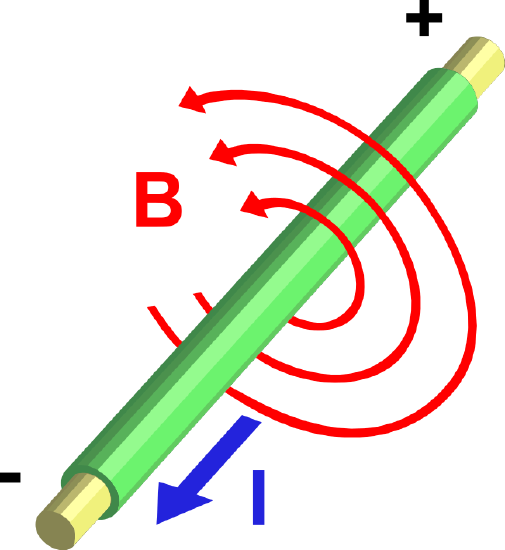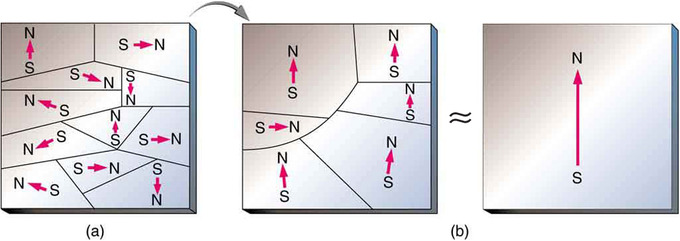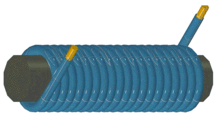21.2: Magnets
- Page ID
- 15647
learning objectives
- Identify two types of magnets
Ferromagnets and Electromagnets
In common language it is often understood that ‘magnet’ refers to a permanent magnet, like one that might adorn a family’s refrigerator, or function as the needle in a hiker’s compass. Such magnets are called ferromagnets. In the second class of magnets—known as electromagnets—the magnetic field is generated through the use of electric current. These magnets can be found in all types of electronic devices. We’ll explore these two types of magnets below.
Ferromagnets
Only certain materials (e.g., iron, cobalt, nickel, and gadolinium) exhibit strong magnetic effects. These materials are called ferromagnetic, after the Latin word ferrum (iron). A group of materials made from the alloys of the rare earth elements are also used as strong and permanent magnets (neodymium is a common one). Other materials exhibit weak magnetic effects detectable only with sensitive instruments. Not only do ferromagnetic materials respond strongly to magnets (the way iron is attracted to magnets), they can also be magnetized themselves—that is, they can be induced to become magnetic or made into permanent magnets.
When a magnet is brought near a previously unmagnetized ferromagnetic material, it causes local magnetization of the material with unlike poles closest, as in. This results in the attraction of the previously unmagnetized material to the magnet as diagramed in. When current produces a magnetic field on a microscopic scale, as illustrated in, the regions within the material called magnetic domainsact like small bar magnets. Within domains, the poles of individual atoms are aligned, and each atom acts like a tiny bar magnet. In an unmagnetized ferromagnetic object, domains are small and randomly oriented. In response to an external magnetic field, the domains may grow to millimeter size, aligning themselves as shown in part (b) of the second figure. This induced magnetization can become permanent if the material is heated and then cooled, or simply tapped in the presence of other magnets.

Current Produces a Magnetic Field: Current (I) through a wire produces a magnetic field (B). The field is oriented according to the right-hand rule.

Unmagnetized to Magnetized Iron: (a) An unmagnetized piece of iron (or other ferromagnetic material) has randomly oriented domains. (b) When magnetized by an external field, the domains show greater alignment, and some grow at the expense of others. Individual atoms are aligned within domains; each atom acts like a tiny bar magnet.
Conversely, a permanent magnet can be demagnetized by hard blows or by heating it in the absence of another magnet. Increased thermal motion at higher temperature can disrupt and randomize the orientation and the size of the domains. There is a well-defined temperature for ferromagnetic materials called the Curie temperature, above which they cannot be magnetized. The Curie temperature for iron is well above room temperature at 1043 K (770ºC). Several elements and alloys have Curie temperatures much lower than room temperature, and are ferromagnetic only below those temperatures.
Electromagnets
In an electromagnet the magnetic field is produced by the flow of electric current. If the current disappears, the magnetic field is turned off. Electromagnets are widely used as components of electrical devices, such as motors, generators, relays, loudspeakers, hard disks, MRI machines, scientific instruments and magnetic separation equipment; they are also employed as industrial lifting electromagnets for picking up and moving heavy iron objects like scrap iron.
An electric current flowing in a wire creates a magnetic field around the wire. To concentrate the magnetic field, the wire is wound into a coil with many turns of wire lying side by side. The magnetic field from all the turns of wire passes through the center of the coil creating a strong magnetic field there. The coil forming the shape of a straight tube (a helix) is called a solenoid, as shown in. Much stronger magnetic fields can be produced if a “core” of ferromagnetic material (such as soft iron) is placed inside the coil. Due to the high magnetic permeability μ of the ferromagnetic material, the ferromagnetic core increases the magnetic field to thousands of times the strength of the field of the coil alone. This is called a ferromagnetic-core or iron-core electromagnet.

Electromagnet (Solenoid): A simple electromagnet consisting of a coil of insulated wire wrapped around an iron core. The strength of magnetic field generated is proportional to the amount of current.
The direction of the magnetic field through a coil of wire can be likend to a form of the right-hand rule. If the fingers of the right hand are curled around the coil in the direction of current flow (conventional current, flow of positive charge) through the windings, the thumb points in the direction of the field inside the coil. The side of the magnet from which the field lines emerge is defined as the north pole.The main advantage of an electromagnet over a permanent magnet is that the magnetic field can be rapidly manipulated over a wide range by controlling the amount of electric current; a continuous supply of electrical energy is required to maintain the field.
Key Points
- Only certain materials, such as iron, cobalt, nickel, and gadolinium, exhibit strong magnetic effects. These materials are called ferromagnetic. Ferromagnetic materials will respond strongly to magnets and can also be magnetized themselves.
- Regions of uniform called magnetic domains are randomly oriented in unmagnetized ferromagnetic material, but may become aligned under the influence of an external magnetic field. This process may become permanent if heated and cooled in the presence of a magnetic field.
- A ferromagnet will lose its magnetism if heated about its Curie temperature.
- Electromagnets are a type of magnet in which the magnetic field is produced by the flow of current.
- A strong electromagnet called a solenoid may be produced by wrapping wires into a coil and passing a current through them. The magnetic field of all the turns of wire passes through the center of the coil, creating a strong magnetic field there.
Key Terms
- magnetic domain: A region within a magnetic material which has uniform magnetization. This means that the individual magnetic moments of the atoms are aligned with one another and they point in the same direction.
- Curie temperature: The temperature above which a material will lose its magnetism.
- solenoid: A coil of wire that acts as a magnet when an electric current flows through it.
LICENSES AND ATTRIBUTIONS
CC LICENSED CONTENT, SHARED PREVIOUSLY
- Curation and Revision. Provided by: Boundless.com. License: CC BY-SA: Attribution-ShareAlike
CC LICENSED CONTENT, SPECIFIC ATTRIBUTION
- OpenStax College, College Physics. September 17, 2013. Provided by: OpenStax CNX. Located at: http://cnx.org/content/m42368/latest/?collection=col11406/1.7. License: CC BY: Attribution
- Electromagnets. Provided by: Wikipedia. Located at: en.Wikipedia.org/wiki/Electromagnets. License: CC BY-SA: Attribution-ShareAlike
- Ferromagnets. Provided by: Wikipedia. Located at: en.Wikipedia.org/wiki/Ferromagnets. License: CC BY-SA: Attribution-ShareAlike
- magnetic domain. Provided by: Wikipedia. Located at: en.Wikipedia.org/wiki/magnetic%20domain. License: CC BY-SA: Attribution-ShareAlike
- solenoid. Provided by: Wiktionary. Located at: en.wiktionary.org/wiki/solenoid. License: CC BY-SA: Attribution-ShareAlike
- Boundless. Provided by: Boundless Learning. Located at: www.boundless.com//physics/definition/curie-temperature. License: CC BY-SA: Attribution-ShareAlike
- Electromagnets. Provided by: Wikipedia. Located at: en.Wikipedia.org/wiki/Electromagnets. License: Public Domain: No Known Copyright
- OpenStax College, Ferromagnets and Electromagnets. January 16, 2015. Provided by: OpenStax CNX. Located at: http://cnx.org/content/m42368/latest/Figure_23_02_02a.jpg. License: CC BY: Attribution
- Electromagnets. Provided by: Wikipedia. Located at: http://en.Wikipedia.org/wiki/Electromagnets. License: Public Domain: No Known Copyright

